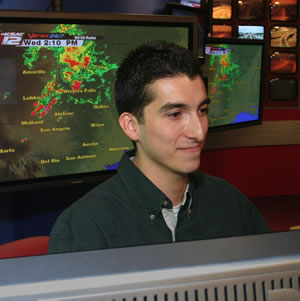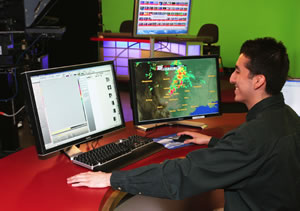Alumnus’ future determined by weather
(UIW’s weather program, that is)
By Mary Frances Monckton Hendrix

Brian Alonzo works at his desk in the production studio at KSAT.
Brian Alonzo doesn’t care whether the day will be sunny, cloudy or rainy; he loves whatever weather blows in. And he loves tracking it for the rest of us.

Alonzo ’07 BS is the weather and traffic producer at KSAT TV, the ABC affiliate in San Antonio, which means he’s behind those colorful graphics we see on the television news. But he doesn’t just put together a pretty map with scattered cloud icons – he carefully researches the weather patterns using radar and computers, and complements his findings with information from the National Weather Service.
“The most exciting part of my job is doing something I love, and that is weather,” Alonzo said. “I love tracking weather, even severe weather. In San Antonio, we’re in a drought. So sometimes I’ll track weather elsewhere in Texas.”
Alonzo uses the forecast prepared by the station’s chief meteorologist to create the weather graphics, but he’s charting the weather, too. “I make my own personal forecast when I get in to work so I don’t get out of practice,” he said.
The skills he uses every day are a combination of on-the-job experience and what he learned while at UIW.
In December 2007, Alonzo was one of the first two graduates of Incarnate Word’s meteorology program. He first enrolled at Incarnate Word to major in communication arts so he could work in journalism and television, but what really called him was meteorology.
While in his sophomore year at UIW, he got a six-month internship working in the weather department at WOAI-TV, the local NBC affiliate. “That’s where I learned to use a lot of the equipment,” he said. That experience and his passion for weather prompted him to transfer to the University of Oklahoma for its meteorology program. At the time, a meteorology program was not offered at UIW.
While in Oklahoma City, Alonzo took a position as an operations technician with KOCO-TV, an ABC affiliate. His experience in San Antonio allowed him to jump right in to making graphics and help during severe weather outbreaks. He realized he wanted to do more with broadcasting, but the University of Oklahoma specialized in research meteorology.
“When I found out Incarnate Word was starting a meteorology program, I decided, ‘I’m going back home!’ I have family here, went to school here; it was the perfect fit for me to come back home.”
So it was in the summer of 2005 that Alonzo returned to Incarnate Word to study under Alex Garcia, an adjunct professor who is also the chief meteorologist at FOX 29 in San Antonio.
“It was sort of a class/internship at his station,” Alonzo said. “We learned how to make a forecast. We would make those graphics for Mr. Garcia.” Toward the end of the course he and the one other student in the class videotaped their forecasts using the Chromakey, also called a green screen.
 Alonzo is responsible for creating the graphics for the weather broadcasts at KSAT.
Alonzo is responsible for creating the graphics for the weather broadcasts at KSAT.
In April 2006, while working on his degree, Alonzo found a position at KSAT. “I was lucky enough to get a job here. I was looking for something in TV and was willing to doanything to get my foot in the door. I’ve been here ever since.”
He said he applies knowledge from his courses in his job daily.
“I work with enough great people to prove to myself what I can do meteorology-wise and be able to put that into a visual reference for our viewers, without the meteorology mumbo jumbo that most people don’t understand,” Alonzo said.
Alonzo said the toughest part of his job is sometimes not having enough time to get everything done. In between deadline work, Alonzo also helps maintain the weather computers, looks after the station’s weather Web site and writes a blog. In the summer,he supervises interns.
He and his colleagues also send bits of information using Twitter or instant messaging among the National Weather Service, area TV stations and county emergency managers.
“For severe weather coverage we’ve opened an avenue of communication to be sure warnings that are issued are verified quickly. Instead of having to pick up the phone, we can do it online a whole lot faster.”
Be sure to read the accompanying story "Forecasting the Future," also in this issue.
